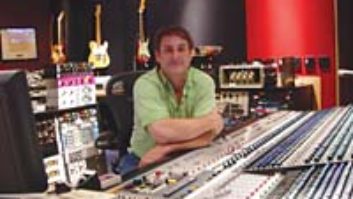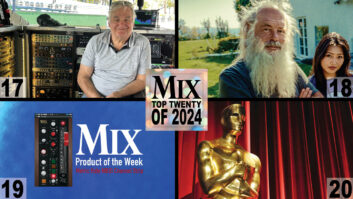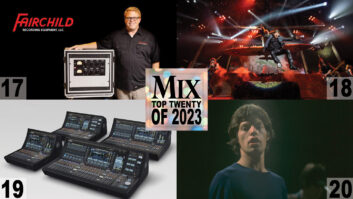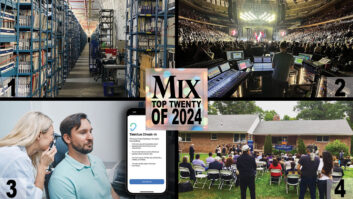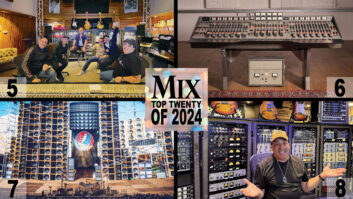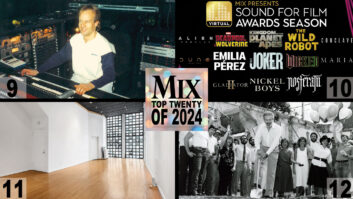Matchbox 20 has experienced a phenomenal run with their debut CD, You or Someone Like You, which has sold millions of records worldwide and spawned five popular singles. The band’s success has built slowly over the course of nearly two-and-a-half solid years on the road, during which they moved from clubs to sold-out arenas. These interviews with some of the key audio personnel took place while the band and crew were putting the wraps on their endless tour last November at the Sydney Entertainment Center in Sydney, Australia. There, the group was also completing work on a documentary about the band. Thanks to FOH engineer Robert Scovill for assembling this dialog about the tour.
Dean Serletic (tour manager): The band and everyone surrounding them have always believed that the more you put into the tour, the more you get out of it. It’s important for the band to give their fans a tremendous show. Matchbox 20 has been on the road for a long two-and-a-half years. They spent the first ten months in a van pulling a trailer. Then, on the success of the song “Push,” the band was able to move to a bus. From there the tour has grown to a total of four buses and five trucks. Besides going all over the U.S., the band has toured all of Canada twice, Europe three times, Japan twice and Australia three times. The strongest overseas market for this band is Australia. The band spent many weeks at the number one position on the Billboard chart in Australia this year.
SYSTEMSRobert Scovill (FOH engineer): I’ve been with Matchbox 20 since July 1998, which was the beginning of The Big Rock Show tour. At that time, they were right in the midst of changing mixers, as well as sound companies, and they contacted me on the recommendation of M.L. Procise at Showco. M.L. and I had been conversing for quite some time-months really-looking for an avenue to get me mixing on their system for a given tour. After speaking at length with Matt [Serletic, the band’s producer] and Dean Serletic, I felt pretty confident that I was going to fit into their camp pretty well. Especially because Matt and I seemed to share a lot of the same approaches to getting sounds, etc. Once we started rehearsals and Matt got a sense of how I was going to approach mixing the band, as well as my approach to sound reinforcement in general, it was apparent that we were not only on the same page but definitely reading from the same book, so to speak. He is a very sharp guy, and I have developed a lot of respect for him.
For these shows in Australia, we were mixing on S-4s as opposed to the Prism System we used in the U.S. Given that the S-4 and the Prism systems really could not be much further apart in design philosophy and application, as well as sound, it has been a surprisingly smooth transition. There are a great number of really fine P.A. systems available around the world these days-much more so than even just a few years ago. They all seem to have their little quirks and idiosyncrasies that you have to learn to deal with on a day-to-day basis, but my feeling is that if you are really on top of your game, you will be able to get the most out of any system that you mix on. There is generally a period of time needed to get acclimated to any sound system. My take on it has always been that the driver makes the race, not the car-you put Michael Andretti behind the wheel of a stock car or Jeff Gordon behind the wheel of an Indy car and in a short time he’s going to be competitive and may even win the race.
Probably the newest thing that I used on the tour is the JBL Smaart Pro software running on a new Dell laptop. This is the first tour where I’ve used it exclusively for assistance in de-equalizing a listening environment. I have since grown to have a great deal of trust in the data that it is providing. In addition, I really love the concept of running real-time FFTs during a performance, as opposed to RTA. It’s a great tool to have on the road. My feeling is that it has really contributed to the consistency in the sound of the show on a day-to-day basis. On the audio gear side of things, I am not using anything that I would consider new. I have made use of some Manley compression that is pretty incredible in sound reinforcement applications. It’s kind of funny in retrospect-some time ago, a sound vendor, who shall remain nameless, contacted Manley on my behalf to purchase some of their equipment because I had specified it for an upcoming tour. Manley, believe it or not, refused to sell it to them: “No, no, our stuff is not made for sound reinforcement. We can’t sell it to you. Good bye.” I remember thinking, “Wait a minute, I need some dynamics control and you make a compressor. Don’t make me come down there!” I have used the Manley equipment in the past for recording and mastering sessions with great success so, in my opinion, it stood to reason that it would work out here. I am happy to report it did the job beautifully.
MONITORSDean Serletic: At first the band was really hesitant to switch to in-ears. It took a lot of persuading just to get the guys to take the time to get molds made. Initially, Paul Doucette the drummer and Rob Thomas were the only two really interested in the system. However, I was able to get enough generic molds for everyone to try. Soon, the whole band had fallen in love with the ears, and stage volume went down about 300 dB. That helped clean up the mix and lessened the effects on the band’s hearing.
Rik McSorley (monitor mixer): I’ve been mixing the band’s ear monitors since they began the American leg of “The Big Rock Show” in July 1998. When we started, everyone but the percussionist was on ears. Before it was said and done, I had him on ears, too. More often than not it’s a combination of ears and wedges, which can be particularly challenging. Most of my experience has been with only one or two people on ears, however.
Mixing an entire band on ears can definitely be challenging at times. Everyone’s ears are a little different and they hear things differently, both sonically and dynamically. I think one of the most difficult things is tone shaping in general, especially the drums. It’s not easy getting a kick drum to sound like a kick drum through a 5mm driver! And just when you get it happening for the drummer, odds are someone else isn’t digging it. So, you have to be flexible and willing to try different things in order to make everyone comfortable with what’s going on in their heads
We have a lot going on here in monitor world with this band. We have three different click tracks, including a click for the video footage. When we started out, it was pretty hairy. Certain guys wanted click on particular tracks, then they only wanted it for eight bars, or some didn’t want it at all. We finally got it all worked out in rehearsals. So, as a result, I have four or five cues for each song. Those cues were probably the most difficult thing to get down.
I’m often asked if mixing ear monitors is more difficult than mixing floor wedges. I can’t say that it is more difficult exactly, just different. Granted, you don’t have the feedback problems or the stage volume to contend with, but it definitely presents a whole different set of problems-not the least of which is operating in such a limited dynamic range.
Ear monitors are very unforgiving. There are things that you just can’t get away with like you can with wedges. Signal processing for instance-you have to be very careful how you apply these devices. For example, with a gate on a kick drum, if your attack time is too fast and it produces a clicking sound it may be okay for the drummer; he’s not going to hear it because his mix is kicking with drums. However, for someone else with a softer, more delicate mix, these extraneous sounds are going to drive them nuts!
Another difference is what goes into the mixes. With wedges, you usually can get by with just what you need to hear to get comfortable and do your job. But being on ears is alien to most performers. They are separated not only from the audience but their instruments as well. So, more often than not you end up doing five or six little house mixes for the band. Everybody wants to hear everything. The challenge is trying to find a place for everything to sit in their heads. I accomplish this with a combination of equalization and panning.
Robert Scovill: The ear monitors give you as the mixer a fighting chance at not having to mix the show at a blistering level. The show runs at a comfortable 102 to 105 dBa and consequently can be very dynamic if needed because of the absence of the stage volume. This also makes for a high degree of coherence in the P.A. system because it is not fighting time smear and frequency masking from the stage volume. In addition, the player’s “error correction,” if you will, is very swift, especially in a vocalist searching for a pitch center or a guitar player’s fretting of their instrument. All of this contributes to a great-sounding show. From my perspective one of the bigger challenges with having every bandmember on ear monitors is the attention to details it requires on everyone’s part. But in the end it’s great because it benefits the listener, player and mixers.
FOH: Midas XL-4 console, two Brooke Siren Varicurves w/remote and wireless option, one Brooke-Siren TCS-804 multi-tap delay.
Dynamics Processing: one Manley Variable Mu, one SSL G384, three Brooke-Siren DPR402s, four UREI 1176s, one Tube-Tech CL1-B, one Summit DCL200A, four dbx 160s, five Aphex 622 gates, two Behringer multiband de-noisers, one Meyer CP-10 EQ, one Valley People PR-2A de-esser.
Effects Processing: one Lexicon 300, two Lexicon PCM 80s, one Lexicon PCM 90, two Yamata SPX990s, one Eventide H3000, two TC Electronic 2290s.
Monitor Equipment: Harrison SM-5 console (U.S. leg), Soundcraft SM-2A console (Australian leg), one Connex AS101 Matrix Switcher (for ear monitors), five Shure PSM600 in-ear monitor systems.
Monitor Dynamics Processing: two Aphex Dominators, two BSS DPR 901 dynamic EQs, four BSS DPR 402 compressor/limiters, four dbx 160XTs, four Drawmer DS201 dual gates, two Klark Teknik DN360 EQs, two UREI 546 dual parametric EQs.
Monitor Effects Processing: two SPX 990s, one SPX 1000, one REX5.

